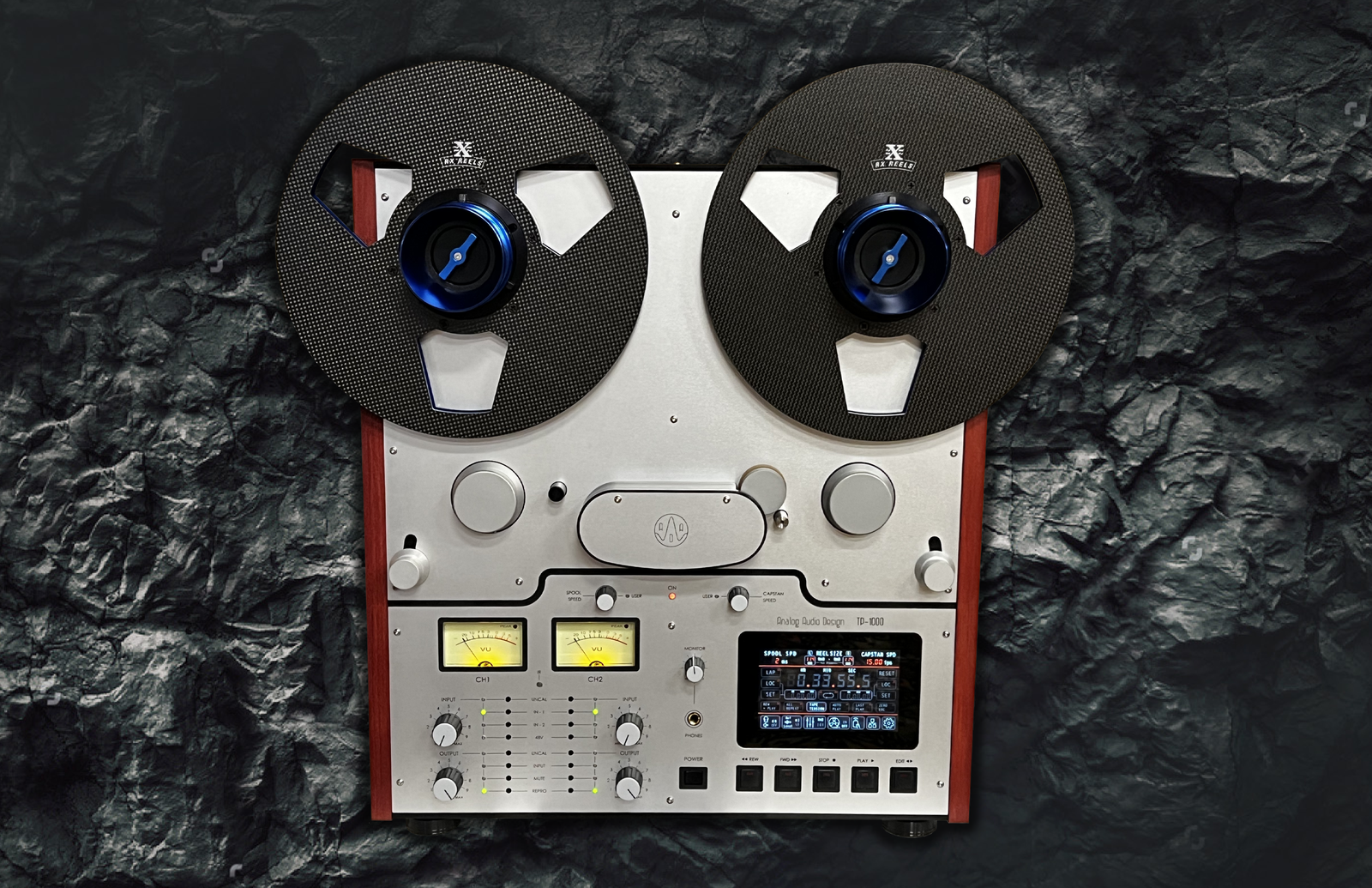Your Cart is Empty

We're excited that reel-to-reel fan and audio journalist Alan McIntosh gave our new 7-inch reel a spin and ranked it very highly! Read the full review of our 7-inch High Fiber Tape Reel below.
Written by Alan McIntosh for Hi-Fi Pig magazine

For the uninitiated (or simply uninterested) a “take up reel”, or simply reel (or spool even) is the casing on which you load open reel tape – formed from 2 circular flanges bound together by a hub whose thickness is that of the chose tape (1/4”, ½”, 1” etc). Usually, you’ll have seen aluminium or plastic ones. Their job seems simple, and to be honest, it really is – keep the tape wound and stored well and let it run through the player when required. We talk “take-up” reels because when you load your nice master copy or recorded tape onto one side of your player you need a second empty take-up reel for it to spool onto either when rewinding a tails-out stored tape before playing or to play onto from a tape that not stored tails out. Still with me?
You’d think then, there is little to talk about when it comes to the comparative merits of a take-up reel and, to an extent, you’re right, they don’t have buttons or dials, DAC chips or capacitors, cables won’t affect them, and you don’t need to worry about precise positioning in your room like that new pair of speakers you bought…that said they do need to do a few things well. Enter stage right then the 7” take-up reel from RX Reels.
Before we get into those “few things they need to do well” let’s look at the RX reel itself. As I mentioned, typically – and this covers all the reels I have to date – the material used to make take-up reels is simple clear plastic or (preferred by me as much to do with aesthetics than function) silver-coloured aluminium and often these are available in varying designs and colours. There is a growing market for “designer” reels – emblazoned with brand names from yesterday (think Revox, Technics, Akai etc) or in funky colours. I for one enjoy the visual aspect of open reel playback almost as much as its sonic wonders so have plumped over time for aftermarket red and gold reels and ATR tape supplies their tape on blue reels. Handmade in the US, RX Reels were founded by a true open tape fanatic and very smiley man (see their website ) Kevin T Root and have opted to forge their own path and have gone for “aviation grade” solid carbon fibre for the flanges.

The flanges are 2.3mm thick and made from 3k 2×2 Carbon Fibre. This means (I had to google the next bit so bear with me! ) sheets of the carbon are woven with 3000 strands, with a 2×2 twill (meaning it uses a balance of 2 warp and 2 weft strands across the weave) which provides both the natty woven appearance and great rigidity while being light. RX claim this is twice the stiffness of steel and five times stronger. The hub itself, formed in aluminium, is securely fixed by 3 screws and is also “over-engineered” to 1/1000” under ISO 9000 standards to provide balance and precision when rolling.
RX offer a great range of styles and colours on their website including a stunning limited run (20 only) of reels in rosewood finish, The fascia of the review one I have is a grey/black weave design and has the RX “X” logo laser etched onto it. The hub where the tape spools onto has been rather cleverly finished with something RX call “nano-grip” to provide a great “grab” on the tape-end for spooling without damaging the fragile tape medium – that said, I always splice about 3” of leader tape to my reels anyway to avoid ever handling the magnetic tape itself. I found that in practise this was the case, and the nano-grab makes spooling a joy with zero slippage that I found vs other tapes where it can be fiddly to get the friction grab needed for spooling when reels don’t have a “notch” for the tape end to sit in.
Finally, the flanges have wide cutouts which make finger threading that bit easier and it makes it a lot easier to monitor tape as you are fast winding back or forward – I hate to forward too much and rely on the brakes once the tape ends, preferring to stop it just before and manually finish it. Rewinding the tape from it I was able to see clearly through the apertures and could gauge when I was bout to reach the tape end, more so than with some others I use. The rigidity also means no warp and so no deck or tape rub. And, as it’s running very true it should cut down motor wear is the suggestion from RX.
With that lot in mind then it’s a good time to remind ourselves what the job of a take-up reel – hold the tape well (check), make it easy to load and spool (check and check), make it easy to visually monitor tape as you are spooling or playing (check).

Apart from these must-haves, we also consider some “nice to haves”. While aluminium reels look a lot better than plastic ones (to me anyway) they do suffer from warping in my experience, even relatively light pressure on a standard aluminium flange and it can bend, just a little. Now in the grand scheme of things, this isn’t game over but it means when watching the reels light bounces in a way that does make you register the warp and this can be very distracting if not disturbing and in an extreme case a warp could mean a flange rubs against the tape as its travelling (not good!). The stiffness of the RX reel really does impress me! While it’s still nice and light (you don’t want added weight on a reel motor if avoidable) it’s rigid, much more so than aluminium and won’t suffer warping as metal can. Compared to plastic it’s far more aesthetically pleasing – another great “nice to have”. At this point, many will ask “does it sound better?”
Overall I don’t think any take-up reel can have a night-and-day impact on sonics unless your stock reels are worn, unevenly run, are somehow allowing slippage or are not set up well – that said, in motion the carbon reels seemed surprisingly to run more quietly than some my other reels, they ran straight and true and released tape cleanly when it came to the end of play. No warping or deviation could I see, and they do provide a sense of a high-grade and attractive reel, which for me underpins whichever tape you are playing – to provide it with the best “bed” to run off.
I adhere to the school of aggregation of incremental gains. Adding a few % of improvement across multiple aspects of my system is important as many who know me will testify. It – and this will have some readers and reviewers spitting their pipes out and quaking in their slippers – makes me “feel better” knowing where I can, and have, improved quality – be it materials, signal path or sonic output I will seek to do so, within my means, for whatever gains it can achieve. When you are in the wonderful world of reel-to-reel with its inherent costs just to own a machine, let alone purchase high-quality audiophile tape, then you are already bought into finding quality gains – even small ones – where you can. Overall, the RX reel merits for construction, innovation, rigidity, materials, grab and aperture size as well as their rather funky aesthetics so they do see me ranking this reel very highly. What I really need now is a 10” one (or two…)!
Build Quality:
Very well put together and with some useful features
Carbon fibre’s stiffness is useful
Sound Quality:
Not applicable here
Value for Money:
Quality does not come cheap. This 7” carbon fibre reel comes in at £116.25 (they are on sale) and 10” range up to £225 for the fancy finishes. One is enough but typically you might want 2!
We Loved:
Construction, material, rigidity, weight, ease of grab on loading, ease of visual monitoring, silent running, aesthetics.
We Didn’t Love So Much
The price may be a stretch.
Elevator Pitch review
If you are seeking warp-proof, high-grade, easy-to-load and true running take-up reels with great aesthetics look no further.

Alan McIntosh
This review appeared in HiFi Pig magazine on March 17, 2023. View the original article here.
RX Reels prides ourselves on manufacturing the world's best carbon fiber reels. Learn more about us and see RX Reels Carbon Fiber 10.5" and 7" reels here.
Looking for a great player? See Reel-to-Reel Players for Sale: The Best Websites To Buy New, Refurbished & Used Decks


This post delves into the topic of making enhancements to the actual recorded media on reel-to-reel tape. Numerous vinyl albums have been remastered, and indeed, several hundred tapes have undergone remastering from the master or near-master. These offer notable improvements in sound quality compared to the original recordings. Sonorus Audio offers a Holographic Imaging tape remastering service explored here.

Analog Audio Design's first product, the TP-1000 is wholly constructed from new components, utilizing technologies such as computer-aided design and advanced testing tools to augment tape transport and minimize distortion.
The all important heads are from AM Belgium, the same company that inherited the head technical specs directly from Studer / ReVox when they shut down.
The TP-1000 stands out as a three-motor machine using DC motors, all uniquely coupled by a belt and a flywheel to a modern design. Why? To reducing the cogging and flutter commonly associated with DC motors.